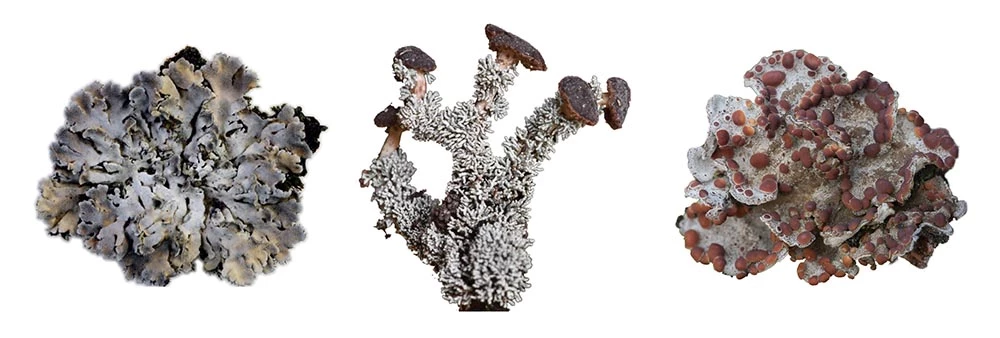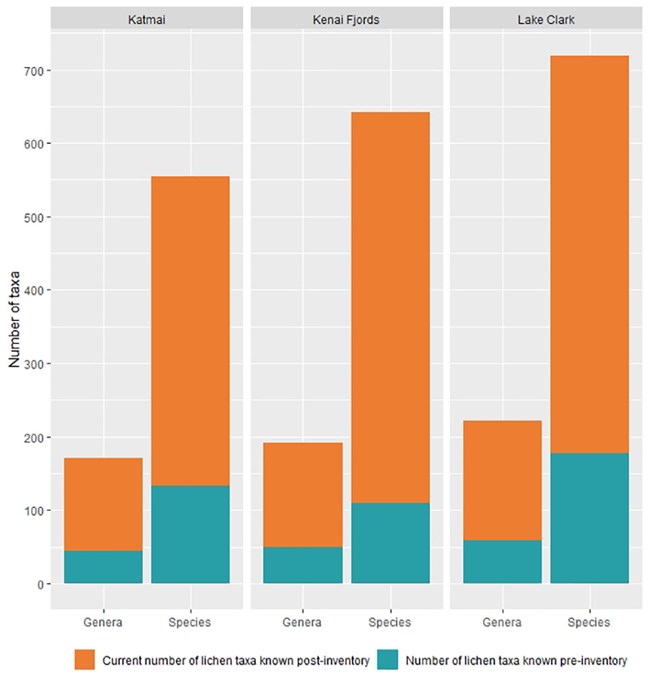Last updated: March 14, 2022
Article
Southwest Alaska Lichen Inventory

NPS/James Walton
Lichens are an important component of biological diversity and are sensitive indicators of air quality and climate. Despite their ecological importance in southwest Alaska, there has been a general lack of information regarding lichen occurrence in the Southwest Alaska Network parks. To address this information need, we partnered with Oregon State University to conduct a lichen inventory of its three largest parks: Katmai and Lake Clark national parks and preserves and Kenai Fjords National Park.

E. Brodo (left), NPS/James Walton (center and right)
Findings
A collaborative team of lichenologists from North America and Europe visited Katmai National Park and Preserve in 2013, Lake Clark National Park and Preserve in 2014, and Kenai Fjords National Park in 2015-2016. They surveyed sites throughout each park that were selected to span a range of rich lichen habitats, including coastal rock outcrops and forests, large interior lakes, river and forest systems, and interior and coastal alpine zones.
Researchers observed a diverse lichen flora spanning a broad climatic gradient from warm, wet oceanic climate in Kenai Fjords and the coast of Lake Clark, to cooler, drier suboceanic and interior climates in Katmai and interior Lake Clark. The high diversity was due in part to the mixing of many floristic elements (species groups showing similar distributions), including Arctic, Amphi-atlantic, Beringian, Boreal, Cordilleran, Northern Oceanic, and Pacific Northwestern. Nitrophilous species (nitrogen loving) did not appear to be abundant in any park, suggesting low levels of nitrogenous pollutants and excellent air quality. Few calciphiles (calcium loving) were encountered, owing to the predominantly acidic rocks in all parks.
To date, at least 16 species have been discovered that are new to science, 13 species are new to North America, and 66 species are new to the state of Alaska. Additionally, new populations of the globally endangered lichen, Erioderma pedicillatum (Hue) P. M. Jørg., were discovered in both Katmai and Lake Clark. Eighteen peer-reviewed journal articles and one master’s thesis have been published using inventory findings. Other products include two manuscripts that discuss the biodiversity and ecology of Southwest Alaska lichen communities through an annotated voucher-based lichen species list and accompanying database for each of the three parks.
| Park | New to Science | New to North America | New to Alaska |
|---|---|---|---|
| Katmai | 7 | 3 | 7 |
| Lake Clark | 7 | 3 | 11 |
| Kenai Fjords | 4 | 7 | 49 |

Over 700 previously undocumented lichen taxa are now recognized across southwestern Alaska parks, representing the largest survey of its kind in the region, as well as one of the largest and most comprehensive lichen inventories in Alaska. Specimens collected during the course of the inventory will be provided on loan to the Museum of the North Herbarium, University of Alaska, and several other institutions, where they will be available for research and educational purposes.
For More Information
McCune, Bruce, et al. 2018. Biodiversity and ecology of lichens of Katmai and Lake Clark National Parks and Preserves, Alaska. Mycosphere: Journal of Fungal Biology 9(4): 859-930.
McCune, B. et al. In Review. Biodiversity and ecology of lichens of Kenai Fjords National Park, Alaska.
To learn more and view current publications.
